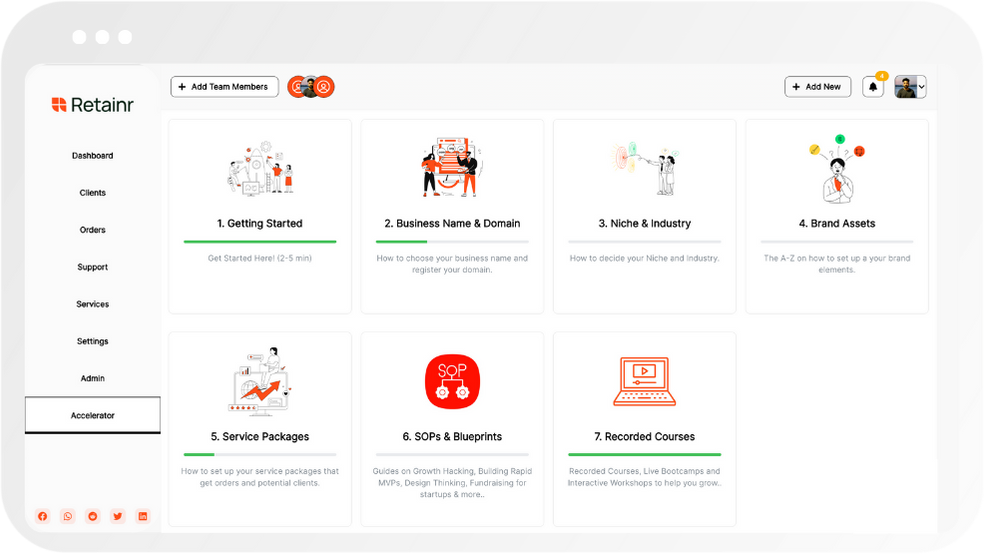
How to Start and Grow a Microbusiness
Build with Retainr
Sell your products and services, manage clients, orders, payments, automate your client onboarding and management with your own branded web application.
Get Started1. What is a microbusiness and how does it differ from a small business?
What is a Microbusiness?
A microbusiness, also known as a microenterprise, refers to an incredibly small-scale business usually owned and operated by one individual or a small team. Typically, they have fewer than 9 employees and need less capital to start and operate as compared to larger businesses. Microbusinesses can operate in diverse sectors, from manufacturing and retail to service and technology, reflecting a wide range of goals, markets, and strategies among owners.
Key Differences between a Microbusiness and a Small Business
Though both are small in size, there are significant differences between a microbusiness and a small business. The defining aspects can be differentiated based on aspects such as the number of employees, initial capital, and operational processes.
| Aspect | Microbusiness | Small Business |
|---|---|---|
| Number of employees | Less than 10 | Less than 500 (as per U.S. Small Business Administration) |
| Capital needs | Less capital required | Requires more capital |
| Operational Processes | Simpler processes | More complex processes |
How does owning a Microbusiness differ from owning a Small Business?
- Ownership Structure: A microbusiness owner typically conducts all the operations themselves or with minimal staff involved. This may include marketing, sales, accounting, and customer service. Conversely, a small business owner often delegates tasks across a larger team.
- Financing: Microbusinesses often start with personal savings or small loans. In contrast, small businesses might need substantial loans, venture capital, or angel investing to kick-off.
- Revenue: Microbusinesses usually generate a lower revenue compared to a small business. This is due to the difference in scale and operational capacities of both business categories.
2. What are the first steps in starting a microbusiness?
Identifying your Business Idea
First and foremost, you need to identify what your business will be about. It would help if you had a clear and concise idea that solves a particular problem or fulfills a specific need within the market. This should be something you are passionate about and knowledgeable in.
- Do market research: Conduct market research to understand the viability of your product or service. Identify your target audience and understand their needs and wants.
- Identify the competition: Conduct a competitive analysis to see the strengths and weaknesses of the businesses you will be competing against.
- Create a unique value proposition: Define what makes your product or service different and why customers should choose you over your competitors.
Creating a Business Plan
The next step in starting your microbusiness is to create a business plan. This is a document that outlines your business goals, methods for achieving them, and the timeframe for their achievement.
- Essential elements of a Business Plan:
- Executive Summary: A brief overview of your business.
- Company Description: Provides detailed information about your company and what it does.
- Market Analysis: Details about your target market and competitor analysis.
- Organization and Management: Your business and management structure.
- Products and Services: In-depth information about your product or service.
- Marketing and Sales Strategy: Your strategies for marketing your business and selling your product or service.
- Financial Projections: Your monetary expectations for the business.
Registering your Business and Complying with Legal Requirements
Once you have your business idea and your business plan in place, you need to register your business and comply with any necessary legal requirements.
| Steps | Description |
|---|---|
| Choose a business name and structure | Your business name should represent your brand, and the business structure you choose will have legal implications. |
| Register your business | Your business should be registered with relevant governmental entities to ensure its legality. |
| Obtain necessary permits and licenses | Permits and licenses are often necessary to operate legally. Research the requirements for your type of business and obtain them. |
3. How do you finance a microbusiness and what are potential sources of funding?
Funding a Microbusiness
Financing a microbusiness can be challenging as it requires meticulous planning and resource management. Here are some possible ways to fund your microbusiness:
- Savings: This is the most direct and common source of funding. Many microbusiness owners initially inject their own savings to fund their businesses.
- P2P lending: Peer-to-Peer lending platforms facilitate lending between individuals bypassing traditional banking institutions. They are especially useful for start-ups and small businesses.
- Microloans: Certain financial institutions and NGOs provide microloans specifically aimed at start-ups and microbusinesses.
- Crowdfunding: Websites like Kickstarter and Indiegogo allow businesses to raise funds from a large number of people.
Comparing the Funding Sources
Each funding option has its pro and cons. Below is a table showing a brief comparison of the four main funding sources:
| Funding Source | Advantages | Disadvantages |
|---|---|---|
| Savings | No repayments or interests to worry about | Limited to what you have saved and potential financial risk |
| P2P lending | Easier access to capital, lower interest rates | May require good credit score, involves interest repayments |
| Microloans | Preferential interest rates for small businesses, more access to finance | Requires rigorous business plans, may involve complex application processes |
| Crowdfunding | Gain validation for your business idea, large collective funds | If funding goal is not reached, no funds are received |
Choosing the Right Funding Source
Choosing the right funding source depends heavily on individual business circumstances, it requires understanding your business plan, knowing how much funding you need and what you can afford. Prioritizing legal and financial consultations can be pivotal in determining the best route for obtaining funding for your microbusiness.
4. What kind of planning is necessary before starting a microbusiness?
Creating a Business Plan
Before starting a microbusiness, it’s essential to have a well-documented business plan as guidance. Such a plan should include:
- a detailed description of your business including its objectives and target audience
- a market analysis outlining your competitors and market trends
- a marketing and sales strategy which outlines how you'll attract and retain customers
- an organizational structure listing the business owner, employees, their roles and responsibilities
- a financial projections giving an overview of your business’ financial outlook
Identify the Necessary Legal and Regulatory Framework
Microbusiness owners must also familiarize themselves with the legal and regulatory requirements of running a business. These may include:
| Legal/Regulatory Requirement | Description |
|---|---|
| Business Registration | Essential process to officially establish your microbusiness |
| Licensing and Permits | Depends on the nature of your business, necessary permits and licenses should be acquired |
| Business Taxes | Understanding tax obligations applicable to your microbusiness |
| Employment Laws | If you plan on hiring staff, being knowledgeable about employment laws is necessary |
Financial Management
Finally, planning your financial management will help secure your business’s sustainability. Implementing accounting and financial tracking systems will give you constant insights into your business’s financial health. Further, setting up a budget controlling your costs and investments will also guide your business decisions. Necessary elements of financial planning include:
- Accounting System: To track income, expenses, and profitability
- Budget Plan: To control operational costs and guiding investment decisions
- Financial Goals: Sets a clear financial outlook and guides progress tracking
- Funding Source: Identifies your capital sources, whether it's personal savings, loans, or investors
5. What are some effective strategies for growing a microbusiness?
Effective Strategies for Starting a Microbusiness
Starting a microbusiness requires a strong foundation to ensure its success in the future. First, it's important to have a clear business plan that outlines your goals, target audience, and strategies. Secondly, developing a unique selling proposition (USP) can set you apart from the competition. Lastly, leverage digital platforms such as social media and e-commerce websites to reach a wider audience.
- Clear Business Plan: This serves as a roadmap that guides your business decisions and helps you stay focused and aligned with your business goals.
- Unique Selling Proposition: This is what makes your business unique, and attracts your potential customers.
- Leverage Digital Platforms: Social media and e-commerce websites are key tools to market and sell your products or services.
Strategies to Grow a Microbusiness
Once the business is set up, it's time to focus on growth strategies. The most effective growth strategies include building strong customer relationships, investing in quality products and services, and continuous market research.
| Strategy | Description |
|---|---|
| Strong Customer Relationships | Engage your customers through excellent customer service and build trust with them. This can lead to repeat business and referrals. |
| Quality Products and Services | Offer products or services that meet or exceed customer's expectations. High-quality offerings attract and retain customers. |
| Market Research | Stay updated with market trends and customer needs. Use these insights to improve your offerings and stay competitive in the market. |
6. What are the common challenges in starting and growing a microbusiness and how can they be addressed?
Common Challenges in Starting and Growing a Microbusiness
Starting and growing a microbusiness often comes with unique challenges and obstacles. Some of these include:
- Limited resources: Microbusinesses typically have smaller budgets and fewer employees, which can make it difficult to compete with larger companies.
- Lack of experience: Many microbusiness owners are first-time entrepreneurs, and may struggle with aspects of running a business such as marketing, accounting, and legal compliance.
- Difficulty scaling: Microbusinesses can also have a hard time growing, as they often lack the necessary infrastructure and resources to scale their operations.
Addressing These Challenges
While these challenges can be daunting, there are strategies and solutions that can help microbusiness owners navigate these obstacles:
- Make the most of available resources: To compensate for limited resources, microbusiness owners can leverage freelancers and outsourcing, use digital marketing and social media to reach customers, and take advantage of free or low-cost online tools for tasks like scheduling and accounting.
- Seek out learning opportunities: For those lacking in experience, there are many resources available, including online courses and workshops, books, and mentoring programs.
- Create a growth plan: To overcome challenges in scaling, it can be beneficial to have a strategic growth plan in place. This might entail identifying potential areas for expansion, setting achievable goals, and outlining the resources needed to reach those goals.
Challenges Vs. Solutions
| Challenges | Solutions |
|---|---|
| Limited resources | Leverage freelancers, digital marketing and low-cost tools |
| Lack of experience | Seek education through courses, books, and mentors |
| Difficulty scaling | Create a strategic growth plan |
7. Is a physical location necessary for a microbusiness or can it be operated online?
Physical Location or Online for a Microbusiness
A microbusiness can either thrive in a physical location or can be operated online. The choice between the two largely depends on the type of product or service your microbusiness is offering. For services or products that are digital or can be delivered or serviced remotely, such as an online coaching service or digital products, an online-based microbusiness is feasible. Here are some perks of going online:
- Reduced Operating Costs: An online microbusiness eliminates the need for a physical location which can significantly reduce operating costs such as rent or leases.
- Greater Reach: Online businesses can reach a vast global audience, which may not be possible for a physically located microbusiness.
- Flexible Working Hours: If your product or service allows, you can operate an online-based microbusiness 24/7.
Physical Location Advantages for Microbusiness
On the contrary, a physical location may be essential for some types of microbusinesses. For instance, if your microbusiness is a coffee shop or a hair salon, you will need a physical location. Here's an outline of some advantages of having a physical location:
| Advantage | Description |
|---|---|
| Face-to-Face Interaction | Provides an opportunity to establish a personal connection with customers. This can potentially increase customer satisfaction rates and build loyalty. |
| Instant Feedback | Customers can give immediate feedback or complaint about a product or service giving you a chance to rectify or improve it swiftly. |
| Physical Evidence | Customers may feel more comfortable buying products they can touch or feel or services they can verify with their own eyes. |
Hybrid Microbusiness: The Middle Ground
In some cases, you might find that a hybrid model of both physical and online presences works best for your microbusiness. This approach offers the best of both worlds, allowing you to reach a wider audience without losing the advantages of face-to-face interactions. Ultimately, deciding whether to go for a physical location, an online presence, or a combination of both boils down to the nature and needs of your particular microbusiness.
8. How do you market a microbusiness to attract more customers and increase sales?
Understanding Your Target Market
Before you can effectively market your microbusiness, you need to understand who your target customer is. This includes understanding their demographics, what they want, and how your product or service meets their needs. Consider:
- Age Group
- Geographical Location
- Lifestyle
- Spending Habits
- Needs and Preferences
Selecting Appropriate Marketing Channels
The channels you use to market your microbusiness depend largely on your target audience. You should consider where your customers are most likely to see your advertising. Some effective channels for microbusiness marketing include:
- Online Advertising (Google Ads)
- Social Media Marketing (Facebook, Instagram, LinkedIn)
- Email Marketing
- Local Events and Networking
Marketing Strategies and Techniques
The key to successful marketing is to make your product or service stand out among competitors. Here are some strategies to consider:
| Strategy | Description |
|---|---|
| Unique Selling Proposition (USP) | Identify what makes your product or service unique, and highlight this in your marketing |
| Customer Reviews/Testimonials | Encourage satisfied customers to leave reviews or testimonials; this can increase credibility and attract new customers. |
| Community Involvement | Get involved in local community events and organizations. This not only increases visibility, but shows a commitment to the community. |
| Direct Response Marketing | This includes tactics such as direct mail, telemarketing, and email marketing that elicit a direct response from the customer. |
9. What legal considerations need to be taken into account when starting a microbusiness?
Legal considerations for starting a Microbusiness
When starting a microbusiness, it is essential to consider various legal aspects to protect your business and avoid future issues. These legal considerations consist of several areas such as business structure, permits, licenses, and legal documentations. Understanding these areas can ensure your business operates within the law, giving it a strong foundation to grow and prosper.
Types of Business Structures
Choosing the right business structure is a vital step in the startup process. Each business structure has different legal implications and can affect your tax obligations, personal liability, and paperwork requirements.
| Business Structure | Legal Implications |
|---|---|
| Sole Proprietorship | Complete personal liability, simple tax implications, low start-up costs, absolute control. |
| Partnership | Shared liability, simplified tax benefits, increased funding potential, shared decision making. |
| Corporation | Lowered personal liability, increased tax obligations, high start-up costs, structured control. |
| LLC | Lessened personal liability, flexible tax obligations, moderate start-up costs, flexible control. |
Permits, Licenses, and Legal Documentation
Permit and license requirements vary depending on the type of business and its location. Typical permits and licenses include: general business operation license, health department permits, and sales tax license. Legal documentation is also crucial to safeguard your business. This could involve contracts and agreements, employment policies, and any copyrights, patents, or trademarks depending on your type of business. It’s a good idea to seek legal advice to make sure everything is covered.
10. How to manage taxes and accounting in a microbusiness?
Managing Taxes in a Microbusiness
Managing taxes in a microbusiness requires meticulous record-keeping and a strong understanding of tax obligations. Here are some key steps you should follow:
- Understand your tax obligations: Different businesses have different tax obligations. Check with your local tax office or a tax professional to understand what yours are.
- Keep accurate records: Strict record-keeping is crucial for accurate tax filing. This means documenting every income and expense, and retain all receipts and invoices.
- Separate personal and business finances: Mixing business and personal finances can complicate tax matters. It's beneficial to open a separate business bank account.
- Consider hiring a tax professional: Taxes can be surprisingly complex. Hiring a professional can save time and might also save money by identifying potential tax deductions you may miss on your own.
Accounting Management in a Microbusiness
Managing your accounting effectively can significantly streamline your business operations and ensure financial stability. Here's how to do it:
- Choose the right accounting system: There are plenty of user-friendly digital accounting systems available that are designed specifically for small businesses. Research and choose the one that fits your needs best.
- Keep track of your expenses: Categorize your expenses, and track them regularly to have clear visibility over your outgoings. You can use table format to categorize the expenses:
- Carry out frequent reviews: Regularly review your financial statements to understand your financial health.
- Get professional help: An accountant can help manage your financials and provide valuable business advice. Consider hiring one if your budget allows.
| Expense Category | Description |
|---|---|
| Rent | Expenses related to your office space |
| Utilities | Electricity, internet, water, etc. |
| Equipment | Purchasing, repairing, and maintaining business equipments |
| Supplies | Stationery, software, etc. that assist your business |
Conclusion
Starting and Growing Your Microbusiness Successfully
Running a microbusiness can be a rewarding and profitable endeavor. It begins with identifying a product or service you are passionate about, conducting thorough market research, and creating a robust business plan. Breaking it down, here are the essential steps for launching and scaling your microbusiness:
Identify Your Product or Service
Find a product or service in which you have expertise or passionate interest, thus motivating you to sustain the business in the long run. It's also crucial to make sure that there's a demand for your product or service.
Conduct a Thorough Market Research
Understand your competition and identify your target market. This should give you insight into pricing, promotion, and distribution strategies.
Create a Business Plan
Your business plan should outline your business strategy, financial projections, marketing approach, and the organizational structure of your business.
Profitably Manage Your Microbusiness
As your business grows, consider transitioning to a more efficient management system. The Retainr.io platform provides a turn-key solution. This whitelabel software allows you to sell, manage clients, orders, and payments under your own branding.
Use Retainr.io for More Efficiency
Retainr.io aids in managing the different aspects of your business thereby giving you more time to focus on core business activities. Not only does this ease the burden of multi-faceted business management, but it helps streamline processes for efficiency and profitability.
With Retainr.io, running your own business has never been more manageable. Remember, starting a business requires passion and resilience, but growing it requires smart strategies and the right tools.
Boost Your Agency Growth
with Retainr Accelerator
Uncover secrets, strategies, and exclusive blueprints to take your agency's growth to the next level — from marketing insights to effective presentations and leveraging technology.

SOPs, Cheatsheets & Blueprints
Leverage 50+ SOPs (valued over $10K) offering practical guides, scripts, tools, hacks, templates, and cheat sheets to fast-track your startup's growth.
Connect with fellow entrepreneurs, share experiences, and get expert insights within our exclusive Facebook community.
.jpg)

Join a thriving community of growth hackers. Network, collaborate, and learn from like-minded entrepreneurs on a lifelong journey to success.

Gain expertise with recorded Courses, Live Bootcamps and interactive Workshops on topics like growth hacking, copywriting, no-code funnel building, performance marketing and more, taught by seasoned coaches & industry experts.

.jpg)

.jpeg)


